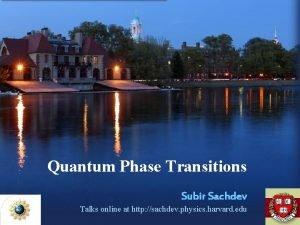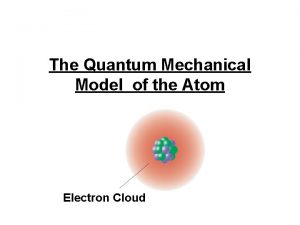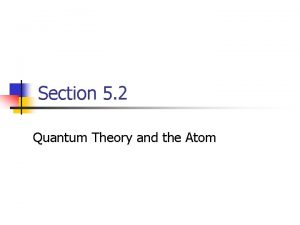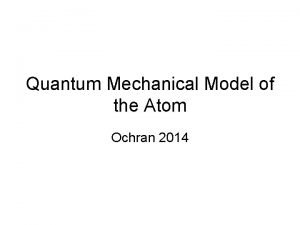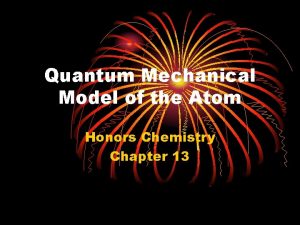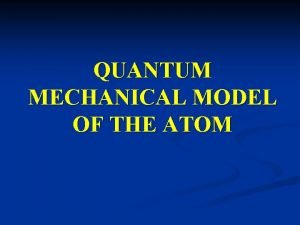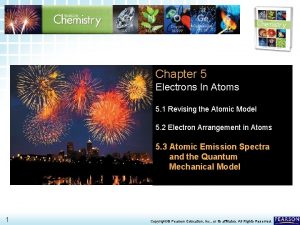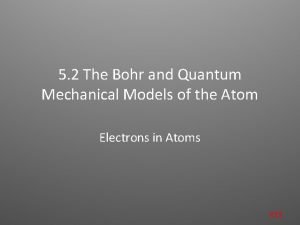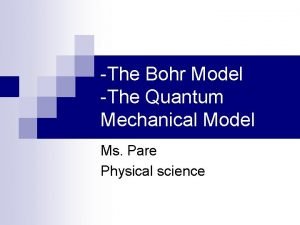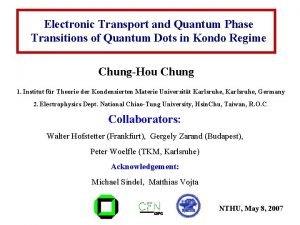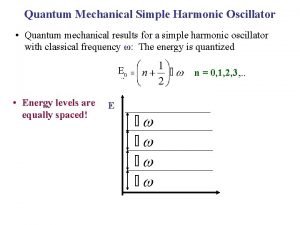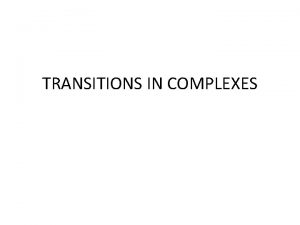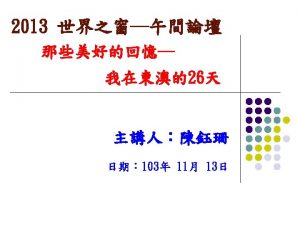Phase Transitions of a Super Quantum Mechanical Matrix












- Slides: 12

"Phase Transitions of a (Super) Quantum Mechanical Matrix Model with a Chemical Potential" (ar. Xiv: 1707. 02898) Takehiro Azuma (Setsunan Univ. ) 40 th Shikoku Seminar, Kagawa Univ. Dec. 23 rd 2017, 15: 35 -15: 55 with Pallab Basu (ICTS, TIFR) and Prasant Samantray (IUCAA)

1. Introduction 2 Static diagonal gauge: d 2<|u 1|>/dμ 2 is discontinuous at μ=1/2 Gross-Witten-Wadia (GWW) third-order phase transition [D. J. Gross and E. Witten, Phys. Rev. D 21 (1980) 446, S. R. Wadia, Phys. Lett. B 93 (1980) 403]

2. The model Finite-temperature matrix quantum mechanics with a chemical potential S = Sb + Sf + Sg, where (μ=1, 2, …. D, β=1/T) ・Bosonic (S=Sb+Sg): D=2, 3, 4, 5… ・Fermionic(S=Sb+Sf+Sg): (D, p)=(3, 2), (5, 4), (9, 16) (For D=9, the fermion is Majorana-Weyl ( Ψ→Ψ ) In the following, we focus on D=3. ) 3

2. The model 4 A(t), Xμ(t), Ψ(t) : N×N Hermitian matrix Boundary conditions: Non-lattice simulation for SUSY case Static diagonal gauge: ⇒ Add the gauge-fixing term Under this gauge Supersymmetry for S=Sb+Sf (μ=0), broken at μ≠ 0.

2. The model 5 Previous works for μ=0 (without Sg) SUSY (S=Sb+Sf) Bosonic (S=Sb) <|u 1|> de-confinement T [Quoted for D=9 from N. Kawahara, J. Nishimura and S. Takeuchi, ar. Xiv: 0706. 3517] T [Quoted for D=9 from K. N. Anagnostopoulos, M. Hanada, J. Nishimura and S. Takeuchi, ar. Xiv: 0707. 4454] Confinement-deconfinement <|u 1|>= a 0 exp(-a 1/T) phase transition at T=Tc 0

3. Result of the fermionic model 6 Result of D=3, N=16, after large-Λ extrapolation: <|u 1|> Gapped⇔ Ungapped large-Λ extrapolation <|u 1|> Λ=8 Possible phase transitions at ( μc, Tc) where <|u 1|>=0. 5, including μ=0.

3. Result of the fermionic model 7 Result of D=3, N=16, after large-Λ extrapolation: History of at Λ=3 No instability in the typical (μ, T) region.

4. Result of the bosonic model 8 Bosonic model without fermion S=Sb+Sg [T. Azuma, P. Basu and S. R. Wadia, ar. Xiv: 0710. 5873] <|u 1|> ρ(θ) (μc, Tc)=(0. 2, 0. 7) D=3, N=48 d<|u 1|>/dμ D=3, N=48 develops a gap. D=3, N=48 d<|u 1|>/d. T

4. Result of the bosonic model 9 Bosonic model without fermion S=Sb+Sg [T. Azuma, P. Basu and S. R. Wadia, ar. Xiv: 0710. 5873] Results of D=3 (D=2, 6, 9 cases are similar) Critical points (μc, Tc) at <|u 1|>=1/2 At (μc, Tc), d<|u 1, 2|>/dμ and d<|u 1, 2|>/d. T are not smooth (d 2<|u 1, 2|>/dμ 2 and d 2<|u 1, 2|>/d. T 2 are discontinuous) ⇒ suggests third-order phase transition.

4. Result of the bosonic model 10 When μ=0, at the critical point Tc 0=1. 1, there is a first-order phase transition at small D. [T. Azuma, T. Morita and S. Takeuchi, ar. Xiv: 1403. 7764] We fit the susceptibility with (γ, p, c) as p=1 ⇒ suggests first-order phase transition. [M. Fukugita, H. Mino, M. Okawa and A. Ukawa, Phys. Rev. Lett. 65, 816 (1990)] D=3 μc 0. 004 0. 01 Tc 1. 095 1. 085 1. 070 p 1. 14(4) 0. 94(3) 0. 42(10) first-order not first-order

5. Phase diagram 11 Phase diagram for D=2, 3, 6, 9 (boson) and D=3(fermion). Some phase transitions at (μc , Tc) where <|u 1|>=0. 5 D=3 SUSY, μ=0: <|u 1|>= a 0 exp(-a 1/T) a 0=1. 03(1), a 1=0. 19(1) ⇒<|u 1|>=0. 5 at T=0. 28. [M. Hanada, S. Matsuura, J. Nishimura and D. Robles-Llana, ar. Xiv: 1012. 2913] μ=0: <|u 1|>= 0. 5 at Tc=1. 39× 0. 52. 30≃0. 28 Fitting of the critical point by Tc=a(0. 5 -μc)b. D 2(boson) 3(boson) 6(boson) 9(boson) 3(fermion) a 1. 36(12) 1. 01(15) 0. 91(9) 0. 90(8) 1. 39(72) b 0. 55(6) 0. 34(7) 0. 25(4) 0. 23(4) 2. 30(59)

6. Summary 12 We have studied the matrix quantum mechanics with a chemical potential ・bosonic model ⇒ GWW-type third-order phase transition (except for very small μ) ・phase diagram of the bosonic/fermionic model
 Subir sachdev quantum phase transitions
Subir sachdev quantum phase transitions Origin of quantum mechanics
Origin of quantum mechanics Quantum physics vs mechanics
Quantum physics vs mechanics Superworm is super strong
Superworm is super strong Quantum mechanical model of atom
Quantum mechanical model of atom Quantum mechanical model labeled
Quantum mechanical model labeled Quantum mechanical atom model
Quantum mechanical atom model Quantum mechanical model definition chemistry
Quantum mechanical model definition chemistry Quantum mechanical model definition
Quantum mechanical model definition Modern quantum mechanical model
Modern quantum mechanical model Atomic emission spectra and the quantum mechanical model
Atomic emission spectra and the quantum mechanical model Quantum mechanical model
Quantum mechanical model Bohr
Bohr
